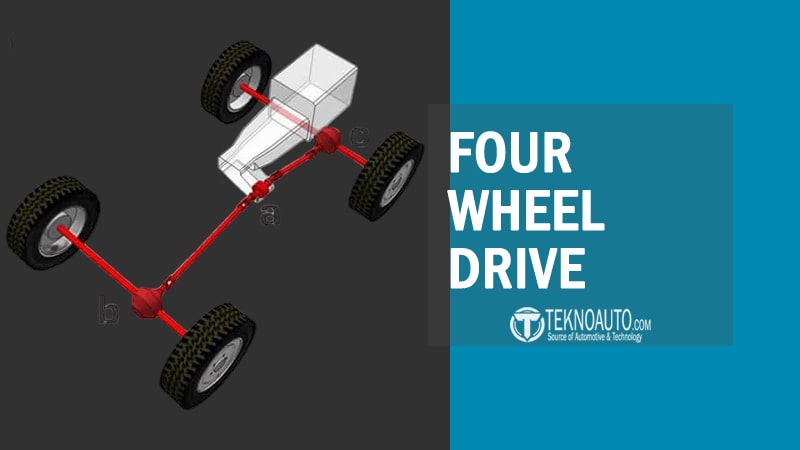From rocky mountain trails to snow-covered backroads, the need for dependable traction has driven automotive innovation for over a century. Among the most rugged and reliable solutions is Four Wheel Drive (4WD)—a drivetrain system engineered not just for getting you from point A to point B, but for conquering the unpredictable terrain in between. Once the domain of military trucks and heavy-duty off-roaders, 4WD has evolved into a widely adopted technology found in modern pickups, SUVs, and even electric utility vehicles.
But what makes 4WD different from other systems like front-wheel drive (FWD) or all-wheel drive (AWD)? Why do seasoned off-roaders, rescue operators, and outdoor enthusiasts still insist on the raw, mechanical precision of Four Wheel Drive? And is it a drivetrain that’s still relevant in today’s world of intelligent traction systems and electric powertrains?
Whether you’re an off-road adventurer, a fleet manager, or simply a curious car owner, understanding the power, capability, and limitations of 4WD can help you make better decisions—on the trail, in the snow, or at the dealership.
What is Four Wheel Drive?
Four-Wheel Drive (4WD), sometimes called 4×4, is a drivetrain system that delivers engine power to all four wheels of a vehicle simultaneously. The primary purpose of 4WD is to enhance traction—especially in off-road, low-grip, or rugged conditions—by ensuring that power is distributed evenly or selectively between the front and rear axles.
Unlike Front-Wheel Drive (FWD) or Rear-Wheel Drive (RWD) systems, which send power to only two wheels at a time, 4WD ensures that all four wheels receive torque, which helps the vehicle maintain grip when one or more wheels begin to slip. This is especially useful when navigating:
- Loose gravel roads
- Deep mud or sand
- Steep inclines or rocky trails
- Snow-covered or icy surfaces
While All-Wheel Drive (AWD) systems may seem similar, 4WD is typically more robust, mechanically driven, and designed with off-road capability in mind. It’s often paired with low-range gearing and locking differentials, which give the driver more control in extreme environments.
4WD systems are common in pickup trucks, off-road SUVs, military vehicles, and utility transporters, where power and durability are critical. Though it may seem like a legacy technology in the age of electric and smart vehicles, Four Wheel Drive remains irreplaceable in applications that demand maximum traction and mechanical reliability.
How Four Wheel Drive Works
Let’s break it down by understanding the key components, the drivetrain layout, and how torque is transferred from the engine to all four wheels.
Core Components of a 4WD System
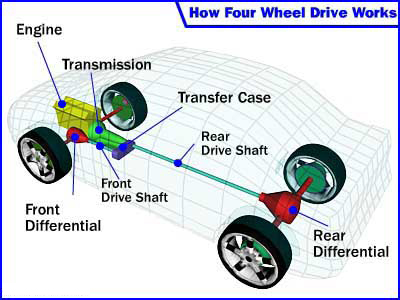
A Four Wheel Drive system typically includes several essential components that work together to control power distribution. These parts form the mechanical backbone of what makes 4WD function reliably in off-road or adverse conditions:
1. Transfer Case
The transfer case is the heart of any 4WD system. It takes power from the transmission and splits it between the front and rear axles. In part-time 4WD setups, the transfer case engages or disengages 4WD based on driver input (manual lever or electronic switch). In full-time systems, it operates continuously and often includes a center differential.
2. Front and Rear Differentials
Differentials allow each wheel on an axle to spin at different speeds, which is essential when turning. In a Four Wheel Drive system, both the front and rear axles have their own differentials to accommodate independent wheel movement.
3. Driveshafts
A driveshaft transfers rotational power from the transmission to the axles. In a 4WD vehicle, you’ll typically find two driveshafts—one leading to the rear axle and another to the front.
4. Locking Differentials (Optional)
Many Four Wheel Drive vehicles—especially off-roaders—include locking diffs that can “lock” the left and right wheels together on an axle, forcing them to rotate at the same speed. This is useful for climbing rocks or crossing uneven terrain where one wheel might lose contact with the ground.
5. Low-Range Gear (Optional)
Found in true off-road-focused 4WD systems, a low-range gear allows the driver to slow down the wheels while increasing torque. This is essential for crawling over rocks, steep inclines, or through deep mud.
How Torque Is Transferred in a 4WD System
In simple terms, torque is the engine’s rotational force. The way Four Wheel Drive transfers that torque determines how the vehicle responds to different driving surfaces.
Step-by-Step Flow:
- Engine generates power, which is sent to the transmission.
- From the transmission, power flows to the transfer case.
- The transfer case then splits torque to the front and rear driveshafts.
- Each driveshaft delivers power to its corresponding differential.
- The differentials distribute that torque to the left and right wheels on their respective axles.
- If equipped, locking diffs or traction control systems further control which wheels receive more torque depending on grip.
Types of Torque Distribution in 4WD Systems
Different types of Four Wheel Drive systems handle torque distribution in distinct ways:
- Part-Time 4WD: Normally drives in 2WD (typically rear), but can engage 4WD manually. Torque is split equally (50/50) front to rear when engaged.
- Full-Time 4WD (Permanent 4WD): Constantly delivers torque to all four wheels, often with a center differential to allow slip between front and rear axles. Torque split can vary (e.g., 40/60, 50/50).
- On-Demand 4WD (Automatic 4WD): Operates in 2WD under normal conditions but automatically engages the second axle when slip is detected. Uses sensors and clutches to manage power flow.
Traction Control vs. Mechanical 4WD
While many modern vehicles use electronic traction control systems to simulate grip by braking slipping wheels, mechanical Four Wheel Drive systems physically deliver torque to wheels that need it. This is why 4WD remains preferred in extreme conditions—it doesn’t just react to slippage, it prevents it.
When Does 4WD Make a Difference?
- Climbing steep trails or mountain passes
- Navigating wet, icy, or snow-packed roads
- Pulling a trailer or heavy load in muddy or loose surfaces
- Crossing shallow rivers, sand dunes, or rocky obstacles
- Maintaining control in remote, unpaved environments
In all these cases, the ability of 4WD to deliver torque to all four wheels simultaneously or selectively gives it a significant edge in traction and control.
Main Types of 4WD Systems
Not all four-wheel drive systems are created equal. While the core idea of delivering torque to all four wheels remains consistent, the way each system operates, engages, and adapts to terrain varies widely. Over time, manufacturers have developed several types of Four Wheel Drive systems to suit different driving needs—from off-road adventure to utility work to comfortable highway cruising with added traction.
This section breaks down the three main types of 4WD systems: Part-Time, Full-Time, and On-Demand (Automatic)—complete with real-world examples and key features of each.
Part-Time 4WD

Part-time 4WD systems are among the most common and rugged types of four-wheel drive setups. In this system, the vehicle normally operates in two-wheel drive—usually rear-wheel drive—and the driver manually engages Four Wheel Drive only when extra traction is needed.
Key Characteristics:
- Operates in 2WD by default, conserving fuel
- 4WD must be manually activated via lever, rotary dial, or electronic switch
- Typically lacks a center differential, meaning it should not be used on dry pavement while in 4WD
- Often paired with low-range gearing for crawling and heavy-duty tasks
Benefits:
- Simple and durable mechanical design
- Lower maintenance than full-time systems
- Offers true off-road performance
- Common in pickup trucks and traditional SUVs
Drawbacks:
- Requires driver awareness and action to engage/disengage
- Not ideal for mixed terrain without stopping to switch modes
- Can cause drivetrain binding on high-traction surfaces in 4WD mode
Examples of Vehicles with Part-Time 4WD:
- Toyota Hilux (4WD variants)
- Ford Ranger FX4
- Jeep Wrangler Sport
- Mitsubishi Triton GLS 4×4
Full-Time 4WD (Permanent 4WD)

Unlike part-time systems, full-time 4WD systems are always engaged. Power is continuously sent to both front and rear axles via a center differential, which allows for differences in wheel speed during cornering—similar to how front or rear differentials work.
Key Characteristics:
- Power is permanently split between front and rear axles
- Uses a center differential to prevent drivetrain binding on dry roads
- Often includes locking differentials and low-range gearing for off-road use
- Some systems allow manual locking of the center diff to act like part-time Four Wheel Drive when needed
Benefits:
- Seamless traction across all types of terrain
- Safer and more predictable in changing weather conditions
- Ideal for drivers who want full-time control without switching modes
Drawbacks:
- Lower fuel efficiency due to continuous drivetrain engagement
- Heavier than part-time systems
- Typically more expensive and complex to maintain
Examples of Vehicles with Full-Time 4WD:
- Land Rover Defender
- Jeep Grand Cherokee (Quadra-Drive II)
- Mercedes-Benz G-Class
- Toyota Land Cruiser 300 Series
On-Demand 4WD (Automatic 4WD)
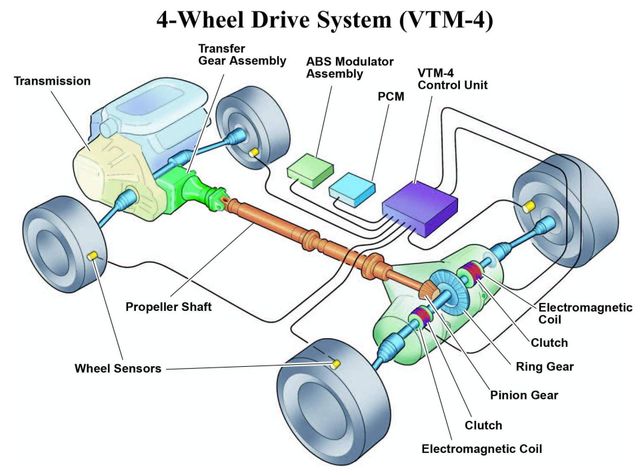
Also known as automatic four-wheel drive, on-demand 4WD systems offer a hybrid approach. The vehicle operates primarily in 2WD mode (usually rear), but automatically engages 4WD when wheel slip is detected via sensors and computers.
Key Characteristics:
- Default operation in 2WD for fuel efficiency
- System detects loss of traction and activates Four Wheel Drive automatically
- Uses electronically controlled clutches or viscous couplings to engage the second axle
- May include selectable drive modes (snow, mud, sand, etc.)
Benefits:
- Hands-free operation
- Ideal for drivers who want occasional 4WD traction without complexity
- Often smoother than manual Four Wheel Drive transitions
- Found in many modern family SUVs and crossovers
Drawbacks:
- May lack low-range gearing, limiting extreme off-road capability
- Less rugged than traditional part-time systems
- Can be more costly to repair due to electronic complexity
Examples of Vehicles with On-Demand 4WD:
- Chevrolet Tahoe Z71
- Nissan Pathfinder 4WD Auto Mode
- Ford Expedition Timberline
- Isuzu MU-X
Comparison Table: Types of 4WD Systems
| Feature | Part-Time 4WD | Full-Time 4WD | On-Demand 4WD |
|---|---|---|---|
| Default Mode | 2WD | 4WD | 2WD |
| Driver Engagement | Manual | Always Active | Automatic |
| Off-Road Capability | Excellent | Very Good | Moderate |
| Fuel Efficiency | Best (in 2WD mode) | Lower | Good |
| Maintenance Cost | Low | Moderate to High | Moderate |
| Terrain Suitability | Rough, off-road | Mixed terrain | Occasional low-grip |
| Low-Range Gear | Usually included | Often included | Rare |
| Vehicle Examples | Hilux, Wrangler | Defender, Land Cruiser | Pathfinder, Tahoe |
Advantages of Four Wheel Drive
Four-wheel drive systems were designed with one core purpose in mind: to maximize traction when conditions are at their worst. Whether you’re tackling rocky off-road trails, pulling a trailer through a muddy worksite, or driving through heavy snow, a Four Wheel Drive vehicle delivers the control, stability, and durability you need.
This section outlines the key advantages of 4WD systems, with real-world applications that demonstrate why many drivers, especially those in rugged or rural environments, continue to rely on 4×4 capability.
Superior Traction in Off-Road Conditions
The most well-known benefit of 4WD is its ability to maintain traction in off-road environments. By delivering torque to all four wheels, the system helps prevent wheel slippage on uneven, soft, or loose terrain.
4WD is especially effective when:
- One or more wheels lift off the ground (articulation)
- Driving over rocks, sand, or through deep mud
- Traversing dirt roads, ruts, or unpaved forest trails
Locking differentials and low-range gearing enhance off-road control by ensuring that torque is evenly distributed, regardless of wheel speed differences. This is a major reason why Four Wheel Drive remains the drivetrain of choice for overlanding vehicles, expedition rigs, and work trucks.
Better Handling in Snow and Mud
Driving in snow, ice, or wet mud can quickly become dangerous without the right traction. With 4WD engaged, the vehicle can send power to wheels that still have grip, helping you keep momentum even if others are spinning.
Unlike FWD cars that often struggle with steep snow-covered inclines, or RWD vehicles that can fishtail under acceleration, a Four Wheel Drive vehicle maintains a better balance of control. This advantage is critical for:
- Mountainous regions with snowfall
- Unplowed rural roads
- Frozen driveways and parking lots
Although AWD systems also offer all-wheel traction, Four Wheel Drive often has the added benefit of low-range gears, which improve torque at low speeds in snow or slush.
Increased Towing Capacity and Load Support
4WD systems are commonly found in vehicles built for towing and hauling—and for good reason. When a heavy trailer or payload reduces traction on the rear axle, 4WD provides additional power to the front axle, improving overall grip and vehicle control.
Whether you’re pulling a boat out of the water, towing a livestock trailer through farmland, or transporting equipment across a construction site, Four Wheel Drive helps maintain forward momentum and steering stability under load.
Benefits for towing include:
- Less wheelspin on launch
- Better traction on dirt or gravel roads
- Reduced strain on transmission in low-grip scenarios
Durability for Harsh Environments
4WD-equipped vehicles are typically built tougher than their two-wheel drive counterparts. They often feature:
- Heavier-duty frames and axles
- Skid plates to protect the underbody
- Upgraded suspension systems
- Higher ride heights for ground clearance
This added durability makes them more reliable in remote locations or industrial settings where rough conditions are the norm—not the exception.
Because of this, Four Wheel Drive vehicles are standard issue for:
- Utility companies operating in rural areas
- Mining and oilfield fleets
- Forestry and wildlife services
- Emergency and military operations
Higher Ground Clearance
While not exclusive to 4WD vehicles, many Four Wheel Drive models come with increased ground clearance, which allows them to pass over larger rocks, tree roots, and other obstacles without damaging the vehicle’s undercarriage.
This benefit is particularly useful when:
- Driving on trails with uneven surfaces
- Climbing steep angles
- Crossing shallow rivers or water-logged roads
Combined with better approach, break-over, and departure angles, this makes Four Wheel Drive trucks and SUVs much more capable in unstructured environments.
Improved Stability and Driver Confidence
Even if you’re not tackling technical terrain every day, the sense of control and predictability provided by 4WD systems can be reassuring—especially for drivers who live in areas with:
- Frequent rain or black ice
- Gravel or unpaved driveways
- Steep elevation changes
Having access to 4WD improves driver confidence, especially when climbing hills, descending slopes, or making tight turns on slick ground. And when paired with modern features like hill descent control, terrain management systems, and electronic traction aids, today’s 4WD platforms are safer and more user-friendly than ever before.
Limitations of Four Wheel Drive
While Four-Wheel Drive (4WD) offers impressive traction, strength, and capability, it’s not without trade-offs. The same ruggedness that makes it ideal for off-road and utility use can also introduce compromises in daily driving—particularly in areas like fuel efficiency, mechanical complexity, and cost of ownership.
Understanding the limitations of 4WD systems is essential when deciding whether it’s the right choice for your vehicle needs, especially if you spend more time on paved roads than uncharted trails.
Reduced Fuel Efficiency
One of the most frequently cited downsides of 4WD systems is their impact on fuel economy. Because Four Wheel Drive vehicles distribute power to both the front and rear axles—either part-time or continuously—they require more energy to operate than their two-wheel-drive counterparts.
Contributing factors include:
- Increased drivetrain resistance from added components like the transfer case and extra driveshafts
- Heavier curb weight, due to reinforced frames and off-road hardware
- Rotational drag, especially in full-time 4WD systems
Even when a part-time 4WD system is not engaged, the added weight and mechanical losses can still reduce overall fuel efficiency. For drivers prioritizing mileage over terrain capability, this may be a deal-breaker.
Higher Maintenance and Repair Costs
A 4WD system adds significant mechanical complexity to a vehicle. This includes extra gears, differentials, driveshafts, and sometimes electronically controlled components—all of which require regular maintenance to function properly.
Potential issues include:
- Worn universal joints (U-joints) on driveshafts
- Leaking or failing transfer case seals
- Differential fluid changes for front, rear, and center components
- Malfunctions in electronic engagement systems or locking differentials
Repairs for these components can be costly and labor-intensive, especially if drivetrain components are damaged due to misuse—like engaging 4WD on dry pavement or ignoring fluid service intervals.
More Complex Driving Behavior
While Four Wheel Drive provides improved traction, it can also introduce handling quirks—especially in part-time systems that lack a center differential. When engaged on dry pavement or high-traction surfaces, 4WD can cause:
- Binding or bucking during tight turns
- Increased tire wear, especially on the front axle
- Reduced steering precision due to the locked torque split between axles
This is why part-time Four Wheel Drive systems are not recommended for use on dry roads, and full-time systems with center differentials are generally more suitable for mixed-surface driving.
Not Ideal for Everyday Urban Use
If you live in a city or suburban area with mild weather and well-paved roads, owning a 4WD vehicle might be more of a burden than a benefit. In such environments, a Front-Wheel Drive (FWD) or All-Wheel Drive (AWD) system often offers better:
- Fuel economy
- Ride comfort
- Maneuverability in traffic
- Affordability in maintenance
The added cost of purchasing and maintaining a 4WD system may not justify its limited utility in typical urban commuting.
Heavier and Less Agile
4WD systems add significant weight to a vehicle—not just from mechanical parts but also from the stronger suspension, heavier axles, and reinforced chassis often found in off-road-capable models. This can result in:
- Slower acceleration
- Longer stopping distances
- Reduced agility in tight urban environments
- Lower payload or cargo efficiency
While this may not matter in off-road or industrial scenarios, it becomes noticeable when using the vehicle as a daily driver.
More Expensive to Purchase
Vehicles with 4WD systems often come with a higher base price, especially when combined with off-road trims, trail packages, or heavy-duty features. Buyers also typically pay more for:
- Larger tires and wheels
- Reinforced underbody protection
- Electronic control systems for terrain management
In many cases, upgrading from a 2WD to a 4WD model can cost thousands of dollars extra, which may not provide return on investment for casual or seasonal use.
Comparison Snapshot: 4WD vs. Other Drivetrains
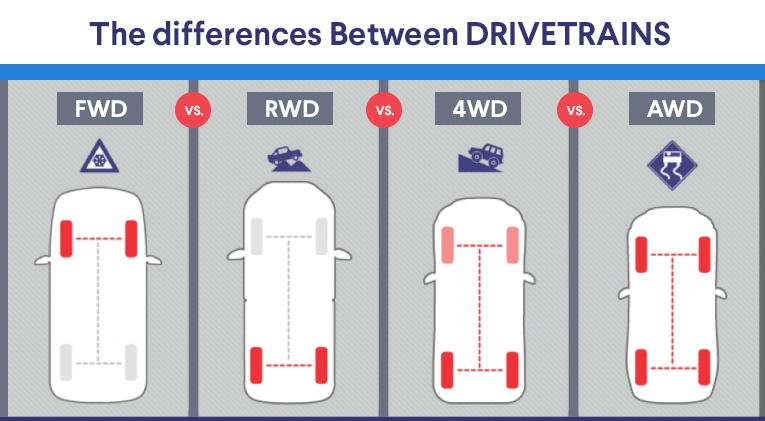
| Feature | 4WD | AWD | FWD | RWD |
|---|---|---|---|---|
| Off-Road Capability | Excellent | Moderate to Good | Poor | Poor to Moderate |
| Fuel Efficiency | Low | Moderate | High | Moderate |
| Handling on Pavement | Poor to Fair | Good | Good | Moderate |
| Maintenance Cost | High | Moderate | Low | Low |
| Ideal Use Case | Off-road, towing, snow | Mixed terrain, weather | Urban, efficiency | Performance, towing |
Although 4WD systems are unmatched in rough terrain, snow, and utility work, they are not always the best fit for daily driving, especially in mild or urban environments. The key is to evaluate your actual driving needs—not just the marketing appeal of rugged capability.
Common Vehicles That Use 4WD
Four-Wheel Drive (4WD) isn’t just a feature—it’s a necessity for certain types of vehicles. While once limited to military and utility trucks, 4WD systems have become integral in a wide range of consumer and commercial vehicles. These vehicles are engineered to perform in the harshest environments, from steep off-road trails to flood-prone construction zones and icy mountain passes.
This section explores the most common categories of vehicles that rely on 4WD systems, along with real-world examples and the specific benefits 4WD offers in each segment.
Pickup Trucks with 4WD
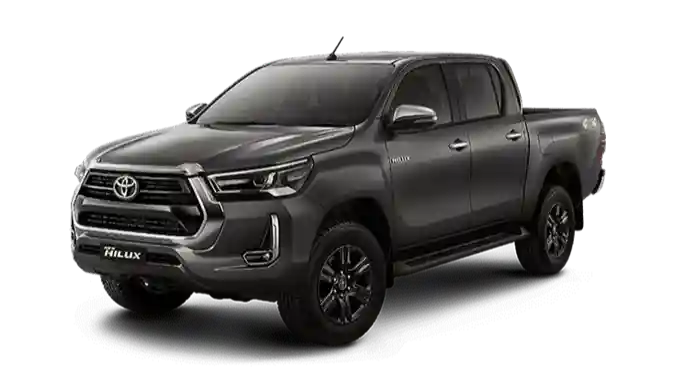
Pickup trucks are some of the most iconic users of 4WD systems. Whether used by contractors, farmers, or outdoor enthusiasts, pickups must often carry heavy loads over loose or uneven terrain. Four Wheel Drive is essential for maintaining traction when the rear wheels alone can’t support the load or climb over obstacles.
Why 4WD Matters in Pickups
- Improves torque distribution for towing and hauling
- Enables off-road mobility for job sites and rural access
- Enhances stability on loose or wet surfaces
- Often paired with low-range gearing for steep climbs or descents
Popular 4WD Pickup Models
| Model | 4WD System Type | Notable Features | Intended Use |
|---|---|---|---|
| Ford F-150 FX4 | Part-Time 4WD | Terrain Management System, off-road shocks | Off-road + work truck |
| Toyota Hilux 4×4 | Part-Time 4WD | Rear diff lock, high ground clearance | Rugged off-road + durability |
| Chevrolet Silverado Z71 | Auto/Selectable 4WD | Hill descent control, skid plates | Mixed use/off-road hauling |
| RAM 1500 Rebel | Full-Time 4WD (optional) | Air suspension, all-terrain tires | Performance + off-road |
| Nissan Navara PRO-4X | Part-Time 4WD | Electronic diff lock, 4LO transfer case | Adventure, construction |
Pickup trucks often include selectable drive modes and off-road packages that enhance Four Wheel Drive performance, making them adaptable across snow, sand, mud, and rocky terrain.
SUVs with 4WD
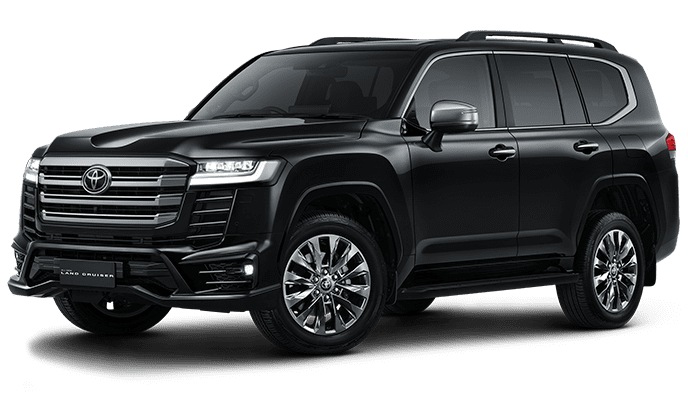
Sport Utility Vehicles (SUVs) combine passenger comfort with utility and versatility, and many are equipped with Four Wheel Drive for enhanced performance in all driving conditions. Unlike car-based crossovers (which mostly use AWD), true 4WD SUVs are body-on-frame and designed for heavy-duty usage.
Why 4WD is Popular in SUVs
- Enables safe travel in adverse weather or unpaved areas
- Supports adventure lifestyles (camping, overlanding, exploring)
- Enhances family safety in rural or mountainous regions
- Often comes with advanced terrain control systems
Well-Known 4WD SUVs
| Model | 4WD System Type | Key Capability | Typical Users |
|---|---|---|---|
| Jeep Wrangler Rubicon | Part-Time 4WD w/ Lockers | Rock-Trac system, solid axles | Hardcore off-roaders |
| Toyota Land Cruiser | Full-Time 4WD | KDSS suspension, crawl control | Overlanding, desert travel |
| Nissan Patrol | Full-Time 4WD | Hydraulic body motion control | Long-distance explorers |
| Ford Everest 4WD | Part-Time 4WD | Terrain Management, diff lock | Family + off-road mix |
| Mitsubishi Pajero Sport | Selectable 4WD | Super Select 4WD II, hill descent assist | Mountain/off-road + city |
SUVs with Four Wheel Drive are ideal for people who want daily drive comfort but also require the confidence to head off-road or handle extreme weather without hesitation.
Utility and Military Vehicles

4WD systems were first popularized through military use—most notably in the original Willys Jeep during World War II. Today, utility and defense vehicles continue to rely on Four Wheel Drive for reliability, durability, and mission-critical performance.
Key Benefits of 4WD in Utility Applications
- Enables access to remote areas (e.g., during disaster relief or firefighting)
- Supports heavy payload transport in uneven terrain
- Offers redundancy and reliability in hazardous conditions
- Withstands extended use under extreme mechanical loads
Examples of 4WD Utility & Military Vehicles
| Model | Primary Use | 4WD System Type | Notable Capabilities |
|---|---|---|---|
| Humvee (HMMWV) | Military transport | Full-Time 4WD | Independent suspension, deep water fording |
| Mercedes G-Class (Military spec) | Armed forces utility | Full-Time 4WD w/ lockers | Reinforced chassis, 100% diff locks |
| Toyota Land Cruiser 78 | Humanitarian/UN missions | Part-Time 4WD | High load capacity, bulletproof durability |
| Ford F-550 Super Duty 4×4 | Emergency/Utility fleets | Part-Time 4WD | Heavy towing, dual rear wheels option |
| Oshkosh M-ATV | Tactical all-terrain | Advanced 4WD | Mine-resistant, extreme articulation |
Vehicles in this category often run under intense mechanical stress, and their Four Wheel Drive systems are overbuilt to withstand terrain and environments that would quickly damage conventional drivetrains.
Specialized Off-Road Vehicles
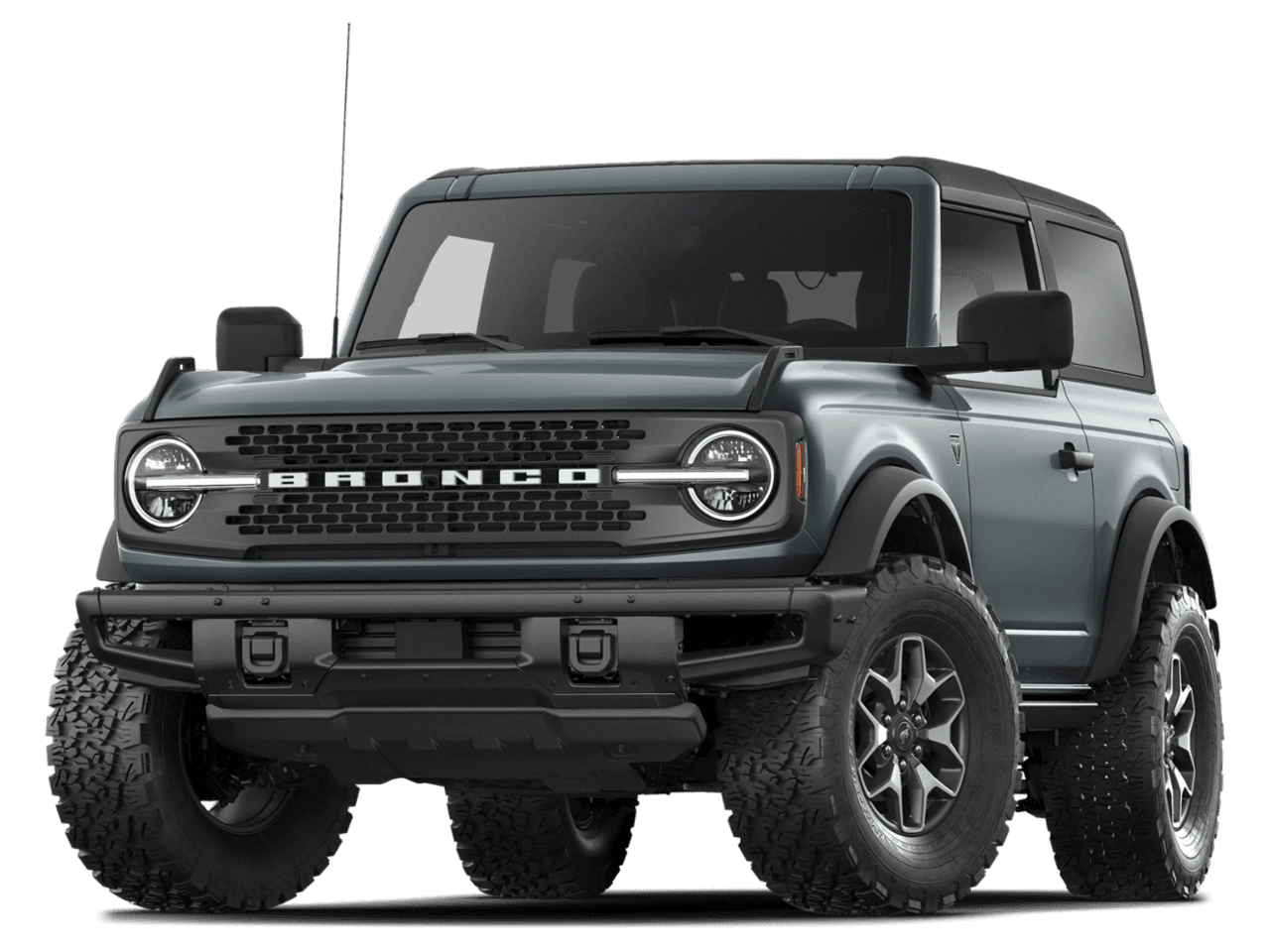
There exists a class of 4WD vehicles designed purely for off-road exploration. These vehicles may sacrifice on-road comfort and efficiency in favor of maximum articulation, approach angles, and drivetrain flexibility. They are typically used by off-road clubs, expedition teams, and adventure travel enthusiasts.
Characteristics of Specialized 4WD Off-Roaders
- Short wheelbase for better maneuverability
- High ground clearance, snorkels, and winches
- Aftermarket support for custom tuning
- Advanced recovery and crawl systems
Popular Models in This Category
| Model | 4WD Features | Use Case |
|---|---|---|
| Land Rover Defender 110 | Full-Time 4WD, Terrain Response | Expedition, overland journeys |
| Suzuki Jimny | Part-Time 4WD, compact size | Trail riding, narrow trail access |
| Ford Bronco Badlands | Selectable 4WD, locking diffs | Rock crawling, sand dunes |
| Jeep Gladiator Rubicon | 4WD + off-road pickup utility | Multi-day off-road camping |
| Toyota 4Runner TRD Pro | Crawl control, multi-terrain select | Backcountry travel and snow |
These vehicles are engineered with extreme geometry in mind—offering exceptional approach and departure angles, reinforced axles, and the ability to crawl, climb, and ford without losing control.
Why These Vehicles Rely on 4WD
Regardless of category—pickup, SUV, utility, or off-road—the presence of a 4WD system transforms a vehicle’s capability from limited to versatile. These vehicles often operate in conditions where 2WD would fail or become unsafe, such as:
- Mountain trails with loose shale
- Construction zones with wet gravel and elevation shifts
- Rural routes in snowstorm-prone regions
- Remote deserts with deep sand and little infrastructure
In these cases, traction isn’t just about performance—it’s about safety, access, and dependability.
Is 4WD Overkill for Most Drivers?
Interestingly, the majority of 4WD vehicles sold today are not used in extreme conditions. Many owners choose Four Wheel Drive for peace of mind, future flexibility, or occasional recreation.
If your vehicle use includes:
- Frequent towing
- Driving on gravel or unpaved roads
- Seasonal snow or mud
- Weekend off-road trips
…then a 4WD system could be a practical and worthwhile choice.
But if you’re mostly in urban or suburban areas with maintained roads and no intention of towing, an AWD or FWD system might offer better fuel economy and lower cost of ownership.
4WD vs AWD: What’s the Difference?

At first glance, Four-Wheel Drive (4WD) and All-Wheel Drive (AWD) may seem like two names for the same thing—they both send power to all four wheels, right? While that’s technically true, the similarities end there. In reality, these two systems are designed for very different driving purposes, use distinct mechanical configurations, and perform differently depending on terrain, weather, and vehicle type.
Understanding the key differences between 4WD and AWD is essential when choosing a vehicle that suits your driving habits and lifestyle.
Core Mechanical Differences
| Feature | 4WD (Four-Wheel Drive) | AWD (All-Wheel Drive) |
|---|---|---|
| Drivetrain Engagement | Manually or selectively engaged | Always active or automatic |
| Center Differential | Rare (uses transfer case instead) | Common in full-time AWD |
| Off-Road Capability | Excellent | Moderate |
| Low-Range Gearing | Usually included | Rare or not included |
| Torque Distribution | Fixed or driver-controlled | Automatically adjusted by system |
| Use Case | Off-road, towing, utility | On-road, light off-road, weather |
| Weight & Complexity | Heavier, rugged | Lighter, more integrated |
| Fuel Efficiency | Lower | Higher |
When to Choose 4WD
Four-Wheel Drive is the system of choice when traction and torque control matter more than convenience or efficiency. Choose 4WD if you regularly:
- Drive off-road (rocks, mud, steep hills)
- Tow heavy loads on slippery or uneven terrain
- Live in rural areas with unpaved or poorly maintained roads
- Need low-range gearing for technical driving conditions
- Want a drivetrain that prioritizes mechanical strength and durability
4WD is commonly found in:
- Pickup trucks
- Off-road SUVs
- Military and commercial vehicles
- Purpose-built adventure and expedition rigs
When to Choose AWD
All-Wheel Drive systems are designed for on-road comfort and safety, particularly in bad weather. AWD systems are typically smarter, faster, and more seamless—making them ideal for drivers who need a balance of traction and drivability without sacrificing everyday convenience.
Choose AWD if you:
- Live in an area with frequent rain, snow, or ice
- Want extra traction but drive mostly on paved roads
- Don’t need low-range gearing or off-road articulation
- Prefer a system that works automatically without driver input
- Drive a family SUV, crossover, or performance sedan
AWD is commonly found in:
- Subcompact and midsize SUVs
- Crossovers and wagons
- Some electric vehicles (EVs) and sports sedans
- Luxury cars with “xDrive”, “quattro”, or “4MATIC” systems
Where Drivers Often Get It Wrong
Many buyers confuse the two systems and end up with either more capability than they need, or not enough. For example:
- A suburban commuter may purchase a 4WD truck thinking it’s safer in snow, not realizing the part-time 4WD system must not be used on dry roads.
- On the other hand, a camping enthusiast may choose an AWD crossover for trail use, only to find out it lacks ground clearance and wheel articulation to handle anything beyond gravel.
Rule of thumb:
- AWD = Best for on-road safety in variable weather
- 4WD = Best for off-road traction and rugged demands
The Rise of Intelligent AWD & Hybrid Systems
Modern AWD systems have become more advanced thanks to traction control, torque vectoring, and adaptive terrain modes. Some AWD vehicles can send power to specific wheels based on grip, steering angle, and acceleration.
Even electric AWD vehicles use dual motors to control torque distribution electronically—no driveshafts or transfer cases required. This introduces new complexity but also incredible responsiveness.
Despite these innovations, traditional mechanical 4WD systems still outperform when durability, redundancy, and raw torque are the priority.
Conclusion
Four-Wheel Drive (4WD) has earned its place as one of the most trusted and capable drivetrain systems ever engineered. From navigating unpaved mountain roads and crawling over rocks to pulling a fully loaded trailer through deep mud, 4WD delivers the kind of rugged performance that other systems simply can’t match. It’s not just a feature—it’s a tool that transforms a vehicle into a go-anywhere, do-anything machine.
Throughout this article, we’ve explored how Four Wheel Drive works, the various types of systems available, and the real-world benefits and limitations that come with it. We’ve also taken a deep look at the kinds of vehicles that rely on 4WD, from heavy-duty pickups and off-road-ready SUVs to military-grade utility platforms and specialized expedition rigs.
However, 4WD isn’t for everyone. It adds weight, increases mechanical complexity, and often comes with higher ownership costs. For urban commuters or those who rarely venture beyond well-maintained roads, a Front-Wheel Drive (FWD) or All-Wheel Drive (AWD) system may offer a better balance of efficiency, cost, and convenience.
But for those who demand more—from their terrain, their tools, or their travel—Four Wheel Drive remains the benchmark for capability. Whether you’re seeking adventure, working in extreme conditions, or simply want the peace of mind that comes with knowing you can handle anything the road (or lack thereof) throws your way, a 4WD-equipped vehicle is a proven ally.
Choose 4WD when the road ends, the weather turns, or the work begins.
FAQ About Four-Wheel Drive (4WD)
What is the main advantage of a Four-Wheel Drive (4WD) system?
The primary benefit of a 4WD system is improved traction in off-road or low-traction conditions. By powering all four wheels, 4WD helps vehicles maintain control on mud, snow, sand, or rocky terrain—making it ideal for off-road driving, towing, or extreme weather.
How does 4WD differ from AWD?
While both systems send power to all four wheels, 4WD is typically more rugged and manually controlled, often with low-range gearing for steep climbs and tough terrain. AWD systems, on the other hand, operate automatically and are better suited for on-road use in rain, snow, or light off-road situations.
Can I use 4WD on dry pavement?
It depends on the type of 4WD system. Part-time 4WD should not be used on dry pavement, as it can cause drivetrain binding and tire wear. However, full-time 4WD systems with a center differential are safe to use on all surfaces.
Does 4WD affect fuel economy?
Yes, most 4WD systems reduce fuel efficiency compared to 2WD or AWD setups. The added weight and mechanical complexity of 4WD require more energy to operate, which often results in higher fuel consumption.
Which vehicles typically come with 4WD?
Common 4WD vehicles include pickup trucks (like the Toyota Hilux and Ford F-150), off-road SUVs (like the Jeep Wrangler and Land Cruiser), military vehicles, and utility trucks used in construction, emergency services, or rural areas.

